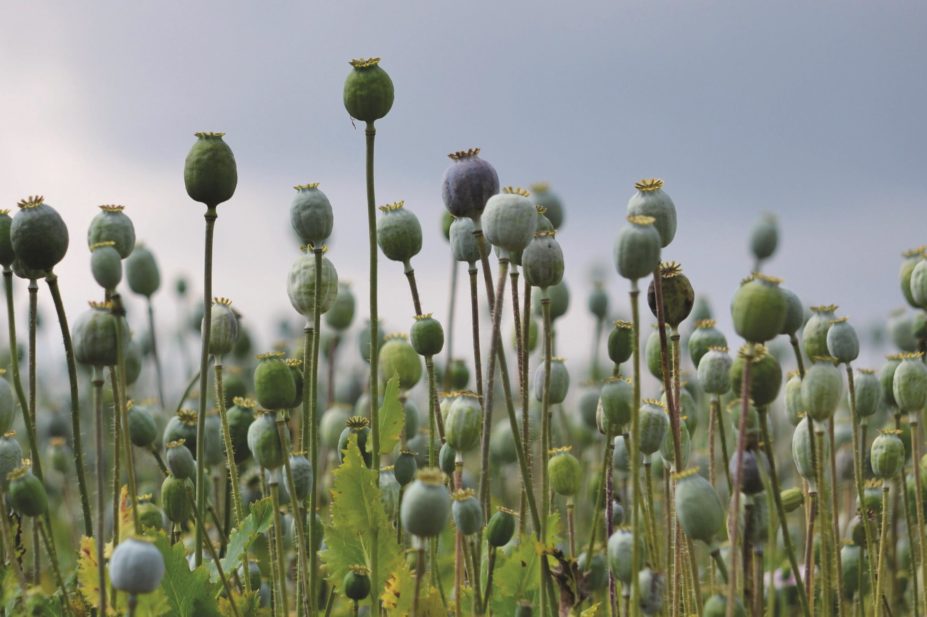
Wikimedia Commons
The production of pharmaceuticals by fermentation is a step closer after the successful genetic modification of yeast to make (S)-reticuline, a precursor to a wide range of therapeutic alkaloids.
Though the breakthrough is significant, it has raised the disturbing question of whether the potential to ferment sugar into opioids could allow almost anyone to produce home-brew morphine – a possibility researchers are determined to thwart.
Currently, most benzylisoquinoline alkaloid (BIA) drugs are derived from plants because chemical synthesis would be too complex. These include antibiotics such as sanguinarine, the cough suppressant noscapine and analgesic opioids like morphine that are extracted from the opium poppy (Papaver somniferum).
There are about 2,500 naturally occurring known BIAs, and plants make all of them from (S)-reticuline. “But it has been hard to study a lot of these compounds in detail because the plants often produce them in vanishingly small amounts,” says synthetic biologist John Dueber at the University of California, Berkeley, of the research team.
They might also enable researchers to develop synthetic opioids that are safer and less addictive than current compound
Genetically-engineered yeast (Saccharomyces cerevisiae) could expedite such studies, because microbes are easier to modify and much faster to grow than plants. They might also enable researchers to develop synthetic opioids that are safer and less addictive than current compounds.
Various research teams have already created different S. cerevisiae strains that carry out the chemical steps to transform (S)-reticuline or related intermediates into morphine, codeine, oxycodone and others. But Dueber and his colleagues have created a form of S. cerevisiae that could feed those processes by turning glucose into (S)-reticuline[1]
. In principle, it should be possible to combine all of these chemical steps into single strains of yeast that produce a wide range of BIAs directly from glucose. The researchers published their findings in Nature Chemical Biology (online, 18 May 2015).
The most difficult part of making (S)-reticuline in yeast has been a chemical step that converts the amino acid L-tyrosine into L-DOPA. To negate this, Dueber’s team tweaked yeast’s genetic code to generate an enzyme called CYP76AD1, usually found in sugar beet (Beta vulgaris). They tested various mutants of the enzyme, and found one that tripled L-DOPA production in the cells, while supressing formation of unwanted side-products.
Then the researchers imbued their yeast with five more enzymes that took L-DOPA through the remaining chemical steps needed to make (S)-reticuline. Overall, one litre of yeast mix produced just 80 micrograms of the compound, but the team believes that improving the efficiency of the other chemical steps should significantly boost that yield.
Their technique developed to identify the best CYP76AD1 mutant could also prove a useful drug discovery tool. They added another enzyme that helps to convert L-DOPA into a fluorescent molecule called betaxanthin, which indicated how much L-DOPA was being produced inside living yeast cells. This allowed them to rapidly screen about 200,000 CYP76AD1 mutants to see which produced the most fluorescence, and therefore the greatest L-DOPA yield.
There is debate over whether fermentation could supersede conventional methods of producing BIAs. High-yielding breeds of P. somniferum brought down the cost of poppy extracts significantly during the previous decade, for example, and the market is not troubled by supply problems or price fluctuations. Tania Bubela, who studies biotechnology law and policy at the University of Alberta, Canada, is sceptical.
“My opinion is that [fermenting modified yeast] is not a cost-effective method for producing wholesale opiate ingredients,” she says.
The spectre of misuse of the science in manufacturing recreational drugs led Dueber and his colleagues to seek advice of Kenneth Oye from the Massachusetts Institute of Technology, Cambridge, who studies technology policy.
Oye urges action by the researchers to prevent misuse. In a Nature comment article on 18 May 2015, he and Bubela concur that engineered yeast strains should stop short of the capacity to produce opioids of abuse, instead producing only close precursors such as thebaine that can be turned into therapeutic drugs using chemical synthesis at strictly regulated production facilities[2]
. Companies that sell bespoke DNA sequences should add those for the key enzymes in opioid production to their watch lists, and laws covering opiate manufacture should be extended to include opiate-producing yeast strains, they add.
Dueber hopes that addressing these issues sooner rather than later will ease concerns about the work. “It’s really important to be prepared to handle this future reality, while keeping our ability to do the research,” he says.
References
[1] DeLoache WC, Russ ZN, Narcross L et al. An enzyme-coupled biosensor enables (S)-reticuline production in yeast from glucose. Nature Chemical Biology (2015). DOI: 10.1038/NCHEMBIO.1816
[2] Oye K, Bubela T and Lawson JCH. Regulate ‘home-brew’ opiates. Nature 521, 281-283 (2015).
You may also be interested in

Competition watchdog launches investigation into discontinuation of bipolar drug

Warwick Smith: ‘The pandemic has removed factors that allowed us to be resilient for Brexit’
